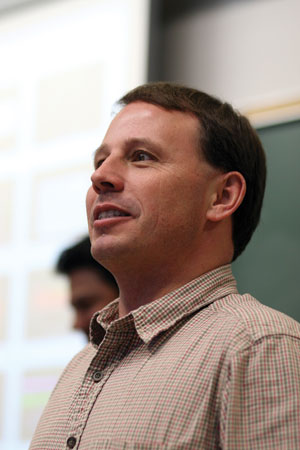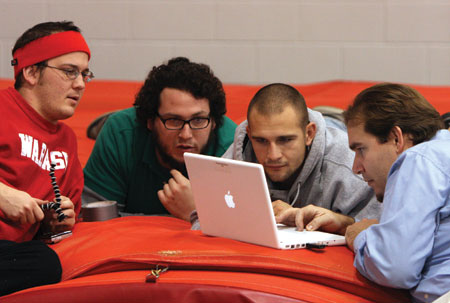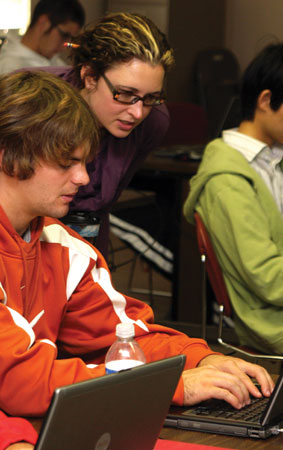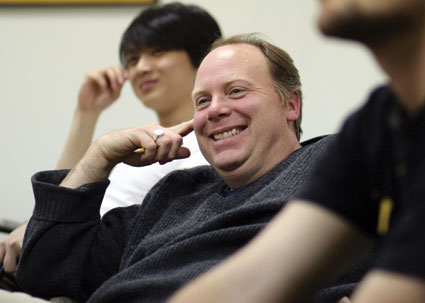To Love the Minds of Young Menby Steve Charles |
| Printer-friendly version | Email this article |
|
“This toothache, painful as it is, provides his epiph-any,” religion major John Torma explains as he flips the through the pages of The Confessions of St. Augustine like he’s shuffling a deck of cards. “It provides his experience of the actual presence of God.” “That’s audacious,” says Spanish Professor Dan Rogers, one of two faculty teaching this section of Colloquium on Important Books, the course in which seniors discuss great books every Wednesday night with a different two professors for each session. “After all he’s been through, and it’s a toothache that brings him to God?” A couple of seniors take the bait, Torma clarifies his point, and Psychology Professor Preston Bost steps to the board to outline the conversation thus far. Used to the chalk and dry-erase boards that line his own classrooms in Baxter Hall, he comments in mock disgust. “Only one chalkboard—why, this is medieval!” English major Elliott Allen doesn’t miss a beat. “This is Center Hall, Dr. Bost. We do a lot more talking here.” And the next hour proves his point. The students are running the class, making and challenging arguments, citing lines and sections from the text, and expressing their perspectives on everything from premarital sex to Manichaeism to the problem of evil. “Augustine’s conclusion is beautiful,” Torma declares. “Evil is the absence of the Divine Spark.” Bost won’t let him off that easily. “But if evil is the absence of something, what drives it? Why is it so prevalent?” And the conversation continues well past the allotted hour and 30 minutes. “I love teaching Colloquium,” is a phrase you’ll hear from teachers of practically every discipline at the College—from Rogers and Bost to math Professor Chad Westphal to German Professor Brian Tucker ’98. “Colloquium approximates a pure liberal arts experience for students and faculty alike, one that is especially important for seniors,” says Tucker, who was a Wabash senior himself only 12 years ago. “They’re at this point in their education where they have to think about what’s next and apply all over to schools and jobs. But Wednesday nights are a space where we all can get back to what an education is really about—coming together to read and discuss books and ideas.” Tucker, who coordinated the sessions in 2009-2010, says he never has trouble finding teachers to volunteer. “It’s my favorite class to teach,” says Rogers. “It’s amazing how prepared the students are, especially considering all the reading they have to do,” says Westphal. who is in his fourth year at Wabash and has taught both Colloquium and the sophomore Cultures and Traditions course. “Colloquium is very much the students’ class. In C & T, I’m often leading the discussion and shaping it. But the students lead the discussion in Colloquium. It’s interesting to see what a difference two years at Wabash can make.” The 2010 Version of Dinner with Ed Haenisch  On my way to meet with Professor of Chemistry Scott Feller on a warm March day, I pass Professor Eric Olofson having an impassioned conversation with a student in front of Hays Science Hall. On my way to meet with Professor of Chemistry Scott Feller on a warm March day, I pass Professor Eric Olofson having an impassioned conversation with a student in front of Hays Science Hall.With Olofson, the topic could be early childhood development (his specialty), or mountain biking, or community-supported agriculture (among his passions). Whatever they’re talking about, they’re face to face and into it. It’s the sort of one-on-one give-and-take that’s the staple of a Wabash education, and Scott Feller believes it’s the norm for a steadily increasing majority of Wabash students. Even in the face of a reduced number of professors, a move made necessary by the financial downturn. It was that crisis that led Feller to look at the College’s history, specifically the last time 78 faculty—the number called for in the current financial model—taught at Wabash. “We went back to look at the course offerings in 1975 and one of the things we noticed is that we no longer offer nearly as many of these large lecture courses with more than 100 students,” Feller says. “Intro chemistry was taught in Ball Theater, and it’s hard to imagine that today. I think last fall the most common class size at Wabash was 15. “And the way intro chemistry is taught today, you couldn’t do it with one person lecturing. We do a lot more small-group and peer learning, a lot more hands-on problem solving. These are the approaches we know engage today’s students.” And from the line of students outside Feller’s office before I was able to get in to see him, you can tell that the 2009 McLain-McTurnan-Arnold Excellence in Teaching Award winner is in the business of engaging students. The research Feller conducts alongside his students is his signature approach to the one-on-one learning he so prizes. The National Science Foundation prizes it, too. Feller just received an additional $500,000 from the National Science Foundation (NSF) to fund his continuing research that has been the springboard to graduate school for more than a dozen Wabash students and has bolstered the reputations of Feller and Wabash in scientific and pedagogical circles. While cooperative research and senior capstone projects provide students in the sciences and social sciences with close-quarters mentoring, Feller says even more students are getting that through courses with an immersion learning component. “Immersion trips are the 2010 version of students sitting at [Professor] Ed Haenisch’s dinner table or road trips with [Professors] Joe O’Rourke or Vic Powell,” Feller says. “For some alumni, going to a professor’s house for dinner and conversation was the epitome of student and faculty interaction. Those dinner conversations do still happen, but I think these trips where students and faculty are thrown into a completely different environment are more powerful, and with more of an intellectual focus, for more students.” “They are also a way to bring along young faculty. Professors who have been here only a year or two can take their classes on one of these trips, be immersed in that intense student-faculty interaction.” That interaction is, to Feller, the most essential aspect of a Wabash education. “If either the lives of students or the lives of the faculty changed in ways that students wouldn’t be lined up outside of our doors, the way they are for professors across campus, that would be our greatest loss.” “Men in Black” AS GOOD AS TODAY’S WABASH CAREER SERVICES office has become, the best entrepreneurial experience the College can offer may still be in the theater—behind the scenes. “I think most people are unaware of the way in which our students have helped organize particularly the back stage portion of our productions in recent years or the ways in which they take ownership,” says Professor of Theater Dwight Watson. He picks up a photograph of the cast and crew from his spring production of Ted Tally’s Terra Nova and points to the “men in black.” “Those are the guys who keep it all together, who are so critical to what we do. “Throughout the last decade, the department has had a number of students who have committed themselves to stage management. What has been so rewarding about that, from a director’s point of view, is to hear students say, ‘We will train and teach and introduce the next generation of stage managers to the theater.’ “Anthony Morton ’10, who was my co-director for Terra Nova, and Cody Grady ’10, our technical director, are prime examples of students who came up through this process. And when I asked which of them would be stage manager for Terra Nova, they told me they wanted to work a younger student into the position. They recruited Jordan Plohr ’12 and he became an exceptional stage manager for the production. “Students taking the managerial aspect of our program with great seriousness helps us establish a high level of accomplishment. I think it engenders respect and a commitment to the process when our students tell their peers, ‘Here’s how we do quality productions at Wabash.’” Watson is grateful but not surprised to see such investment and interest in the theater. “When I think about how many Wabash students gravitate toward organizational leadership, it just makes sense. If students want to understand personnel and scheduling, the accomplishment of tasks within a confined period of time that leads to a promising result—that’s the kind of experience you get as a stage manager. “But our stage managers don’t only focus on the business of running a production. We involve our students in creative decision-making.” He glances down once more at the photograph of his Terra Nova cast and crew. “They were a wonderful group of students, always enthusiastic, so committed.” He points to Cody Johnson ’10, who played the lead. “He was our Captain Scott—his first role ever—and Cody never leaves the stage. He opens with the first line and ends with the last. He’s not a theater major, but I’d like to think that years from now he will look back on the experience as one of the formative moments of his college life.” Steven Apostolidis ’12: Freshman Brain Surgeon STEvEN APOSTOLIDIS WASN’T EXPECTING to perform brain surgery his freshman year. “When Professor Schmitzer-Torbert told me I would be a research assistant, I expected to be observing, cleaning, and assisting with small tasks. From day one of the internship however, I began to realize that was not the case.” That’s not the case with students conducting research alongside Wabash faculty. And certainly not with Schmitzer-Torbert, who in May received a $270,000 grant from the National Institutes of Health to continue his research on the effects of addictive drugs on learning and memory. “The benefits of having a program for research at a college like Wabash is to get students involved in work that will be of interest to a community larger than just the people doing the work,” Schmitzer-Torbert says. “And the professional community will be very interested in the outcome of this research.” As is the NIH. The three-year grant will pay for three students per summer to work with Schmitzer-Torbert, who has high expectations for their involvement, including Apostolidis. “Believe it or not, the brain surgery we do on rats for this study is relatively straightforward, and this is a lab skill students can really benefit from,” the professor says. “I had Steven observe the first procedure, and on the second I asked if he wanted to perform several steps, and by the third he was able to do pretty much the whole surgery.” “In high school I never imagined I would be partaking in research, let alone brain surgery the summer before my sophomore year,” Apostolidis says. He’ll be returning to the lab to assist Schmitzer-Torbert this year. “Stephen can mentor newer members of the team,” Schmitzer-Torbert says as I stop by his office in May for the first meeting of this new group, which now includes freshmen Romeo Amoa and Xumin Sun. The office looks as though they’re getting ready to clean it—the desk, computer, and cabinets are pushed to the walls of the room. But Neil assures me it’s always this way, with chairs in the center for professor and students—space for conversation. “I know many offices you’ll find the desk between the teacher and the students, but that’s not my style,” Schmitzer-Torbert says. “That’s a more hierarchical set-up—when you have a desk between you and the other person, it’s more set up for power over them, where more open conversations are facilitated by not having that desk in the way.” The conversation is certainly open and relaxed, with plenty of questions, as the professor outlines the goals of his research and the work they’ll be doing together. “In grad school, the labs I worked in were interested in training students, but that wasn’t their primary goal, so undergraduates fell into roles that were close to being technicians. They didn’t have a deep understanding of the broader purpose of the research. Whereas at Wabash, when we bring in a grant we’re trying to answer interesting questions in science. But if we did that and, at the end of the day, the students didn’t feel like they were partners in the work—that they hadn’t made a contribution beyond simply helping to run the experiment—then I would view that as a failure.” Physics in the Fieldhouse  In early winter, Physics Professor Martin Madsen is huddled around a laptop computer with a group of students on the high jump mat in the Knowling Fieldhouse. The class is Mythbusters, Madsen’s innovative physics course for non-majors inspired by the Discovery Channel’s hit TV show. In early winter, Physics Professor Martin Madsen is huddled around a laptop computer with a group of students on the high jump mat in the Knowling Fieldhouse. The class is Mythbusters, Madsen’s innovative physics course for non-majors inspired by the Discovery Channel’s hit TV show.“Some of the stuff they do on Mythbusters is real science, and it’s engaging, it’s fun, and it’s exciting,” Madsen says. “I thought, What if we were to do science like they do science, where we present to the students a big picture myth and just let them loose?” Madsen designed a course in which students learn physics and apply their best critical thinking skills to solve problems using that Mythbusters format. Instead of a textbook, they purchase inexpensive video cameras. The class also has access to a high-speed video camera that shoots 600 frames per second. Students produce short videos of their experiments describing the myth, then explain the physics behind either the validation or the debunking of it. “The students have to have a good grasp of the physics to teach it to others,” Madsen says.” The video cameras become the tools for capturing data in the labs and then communicating that data back out.” Today’s myth: Can a train car loaded with grain increase its velocity by dumping its cargo while in motion? With video cameras mounted to carts and set at various angles to capture the experiment, the students push their carts down a path, then dump the cargo of pea gravel as the carts speed across the fieldhouse. The high-speed camera allows the students to measure the rate of velocity throughout the run, and the students are able to determine whether it is possible to gain speed by dumping the gravel. Madsen is excited about how well the class is going. “Oh, it’s definitely working as well as I hoped it would,” he says. “Just watch how the guys throw themselves into these projects. They’re figuring out things on their own—learning the science as they apply it and test it.” And it turns out the students are spending between 10 to 15 hours a week on out-of-class research and project development—more than triple the time they spend in the slotted lecture and lab time. One group of students researched today’s demonstration by talking with workers at a nearby grain elevator. Madsen watches one team accidentally dump its load of gravel for the third time. The professor bursts out laughing so hard that he turns away, hoping the students won’t notice. Then he walks over, leans down, and helps them scoop up the gravel even as he reminds them of the physics that’s just bitten them in the butt for the third time and suggests how to make sure the experiment works the next time. Madsen has harnessed young men’s preferred medium of expression into a powerful learning and teaching tool, and the group-learning format gives him plenty of one-on-one teachable moments with his students. The results are encouraging. “The videos keep getting better and better each week,” Madsen says. “The students are learning how to communicate the science more effectively each time out, and the production quality is vastly improved.” Which raises another advantage of Madsen’s approach: In a society sorely in need of citizens who can understand and communicate the advantages and pitfalls of its technological advances, the ability to clearly communicate the science may be as important as understanding it. From Shame to Celebration  Freshman Comp is the class you’d hoped to test out of. Freshman Comp is the class you’d hoped to test out of.“There’s a remedial taint to teaching composition,” says Assistant Professor of English Crystal Benedicks, who for the past two years with Writing Center Director Julia Rosenberg and faculty colleagues has taken a long, hard look at writing at Wabash. “You get a Freshman Composition class where the guys know they’re getting remediation—they feel like they’re stupid, that their stupidity has been exposed in some way.” Benedicks thought it was time for a different approach. “There are a lot of misunderstandings about writing,” she says. “A lot of students go away feeling hopeless about it, like it’s something you’re either good at or not, and the way we teach writing—as a basic skill that comes prior to the ‘real subjects’—reinforces that. “We have this mysticism about writing—that you think of a great idea that somehow channels itself from your head to the paper with a minimum of pain and confusion. But that’s not what happens when you sit down to write. “Writing is not just translating thoughts to paper—it’s a real activity.” Benedicks decided her students would explore that activity, from writer’s block and audience to the way students’ attitudes toward writing change throughout their school careers. They studied the research, read articles in scholarly journals, and heard visiting alumni talk about their own writing experiences. “The class changed from being a group of students trying to catch up with their peers to students exploring what it really means to be a college writer. When they stopped trying to prove they were good at writing and started interacting with the research, they discovered they could also write about it.” They are also leading the discussion of writing on campus. Two of Benedicks’ students—Paul Hudak ’13 and Colten Craigin ’13—presented their own research on writing at this year’s Celebration of Student Research and Creative Work, where the audience included fellow students, professors, administrators, and trustees. “They came from feeling embarrassed to becoming part of the knowledge-making in their discipline before their peers.” Benedicks smiles. “Students from every major have to write, and every department in the College has a stake in this—all of us are involved in teaching it, and it deserves our scholarly attention. I think you can see that change in the conversations faculty are having about it. “But the first time it was ever presented in a scholarly setting to this community was by freshmen from a composition class. Who would know it, or could do it, better?” “Strange Combinations” I’ve stopped by Physics Professor Eleanor Sayre’s office to learn more about the $130,000 grant she’s received from the National Science Foundation to study how students learn (or don’t learn) physics. But we spend the first hour talking about the liberal arts and sciences. Not that she’s not excited about the grant—particularly the innovative methodology she has developed, the role Wabash students will play in that research, and the benefits it will bring to them. But Sayre, a Grinnell College graduate, wants to talk about what makes liberal arts students different. “The difference between a small liberal arts school and any other school is not the wide variety of courses taken,” she says. “You can find a wider variety of courses at other schools. But there’s an expectation that our students will be widely interested and that they should take risks to find out what those interests are. That’s very different than an expectation that, since you have to take a wide distribution of courses, you might as well just grit your teeth and get through it.” Sayre is a case in point. Interested in physics and poetry, and involved in the theater as an undergraduate, she declared herself a physics major after deciding “it was easier to do theater as a physics major than it was to do physics as a theater major. “But at least in a liberal arts college, I could do both. “So as a liberal arts college we expect a wide variety of interests. We see that in our philosophy/physics double major Chris Beard ’10, or Scott Pond ’10, who is a music major/physics minor about to perform his senior recital. We see what looks on the surface to be strange combinations because we expect our students to be widely interested and to take risks. We encourage it.” “To Love the Minds of Students” IN AUGUST AT EVERY FRESHMAN CHAPEL since he’s been president at Wabash, Pat White has told freshmen to “look into the eyes of the men in your class, these men around you. These men will be your teachers.” I remember that as I photograph another Colloquium on Important Books class in March. The text is Lu Xun’s Diary of a Madman, and this session’s guest teachers are Associate Professor of Religion David Blix ’70 and Assistant Professor of Philosophy Mark Brouwer. As anyone who knows these teachers would expect, it’s a lively session. But once again, the students dominate the discussion. Some even teach each other. Blix and Brouwer ask questions and sometimes challenge the students but always seem to revel in the exchanges. Fifteen minutes past the scheduled ending time, they finally calls it quits. The students climb down the creaking stairs of Center Hall. The professors stay behind to discuss and evaluate the conversations they’ve just had with these 16 seniors of varying majors who have brought all their learning to bear on a single text. Later in Blix’s office, I’m thinking about the classrooms and teachers I’ve visited this semester, the mix of innovative and traditional approaches. I ask this professor who was taught by Wabash legends and is considered one himself, “What is the essential quality of a Wabash teacher?” He says nothing for a moment—a reverent pause. This is, after all, the space where his mentors Eric Dean, Hall Peebles, and Raymond Williams once taught, across from the office where his closest friend, the late Bill Placher ’70, conversed with his students. Then he offers up a phrase that sums up the best of what I’ve seen this year, the best of what I’ve seen at Wabash for 15 years, and the best advice I’ve heard for young Wabash faculty: “I think, in a sense, one needs to love the minds of students. Here, of course, that means one needs to love the minds of young men.”
|

 It’s 7:45 on a chilly autumn night and 16 Wabash seniors in the only lit classroom in Center Hall are wondering aloud how St. Augustine found God in a toothache.
It’s 7:45 on a chilly autumn night and 16 Wabash seniors in the only lit classroom in Center Hall are wondering aloud how St. Augustine found God in a toothache.